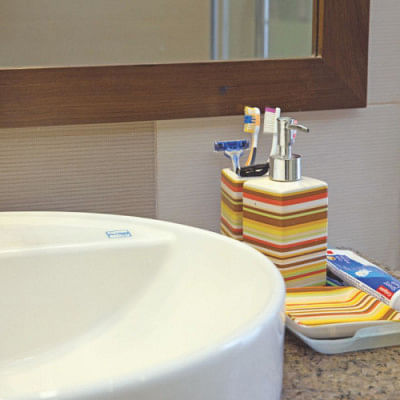The Art in Bathing

It is only during the last century that bathing became a private affair. For centuries, bathing was an essential part of social life, and baths were an important meeting place, a social centre for relaxation and debate. The baths and the bathing ritual were an opportunity for both exercise or rest -- a recreation complex at its best.
Tropical bathing was very interesting. People used to take their bath at the pond or river near their homes. Earlier in Bengal, almost every house had its own pond within the homestead's boundary. So much of our life has been spent in bathrooms that one could even argue that they are the most important zone in a house. The Balinese associate their spring-fed bathing places with the meditation caves of ascetics who once used them.
Bathing has remained a solitary pursuit during the last century. In fact, the Victorians, who developed sophisticated hot water and plumbing systems, still held the attitude that one bathed out of necessity and for hygienic purposes only. This sentiment still perpetuates today, and the bath is still mostly confined to being inside a room.



Bathing should be restored to its rightful place as both a pleasurable and relaxing activity, which can be enjoyed either alone or as a couple. Often it is the only time we have to ourselves in the day, so we should make the most of it in an environment which offers a healthy ambience and promotes relaxation and even intimacy.
Bathing should be a celebration of the human form. As the concept of the open bathroom gains popularity, contemporary architects have started to experiment with ways in which the design could be used in renovated or modern houses in urban settings.
Space, of course, was the main consideration: in hotel complexes or in country houses, private gardens with outsides views are not difficult commodities. In the city, it is an entirely different matter.
Architects have risen to the challenges posed by space constructions, by employing natural materials in the small spaces available – pebbles, stones, wooden decks, potted plants and the like.
The most popular style is contemporary, with elegance in focus, and the dream for many. Functionality is of course important too. As a designer, I suggest and prefer a washbasin with a long counter. A basin paired with a basin mixer creates a smart and gorgeous look. The Jacuzzi style hot tub is another modern addition, with a triangular white Jacuzzi. It allows for a very relaxing bathing option, especially as the pressure and circulation of water is very soothing.

It can be argued that luxury bathing is very time consuming, for which we have the customised standing shower box. This box has a separated wet area from the dry zone as the key feature, often an absolute must for contemporary or modern bathrooms.
ariety in the use of bathroom tiles can also enhance cleanliness and beautification. We choose beige and deep brown tiles for this master bathroom, with floral décor pieces and borders placed symmetrically for added effect.
Lights should always emphasise decoration, so I arranged a sleek false ceiling for the bathroom, to help indirect lights and accent lights illuminate and create the whole ambience. Dressing is the most important issue right after bathing usually, so we placed a sleek dressing unit arranged into one side of the space. The long mirror enhances the whole area. A decorative glass adds some oomph to the place.
Bathing is still quite a clinical affair in general, and focused on massaging and scrubbing away our natural body oils and odours, sometimes along with the skin's protective covering. Using perfumes and oils, massaged into the skin, can help with restoring the balance after a relaxing bath, and keep our bodies supple and fragrant.

By Nazneen Haque Mimi
Interior Consultant
JOURNEYMAN
E-mail: [email protected]
Photo Credit: Tamim Sujat
Special Thanks: Mrs. Shahnaz Fatema Mousume

 For all latest news, follow The Daily Star's Google News channel.
For all latest news, follow The Daily Star's Google News channel. 



Comments